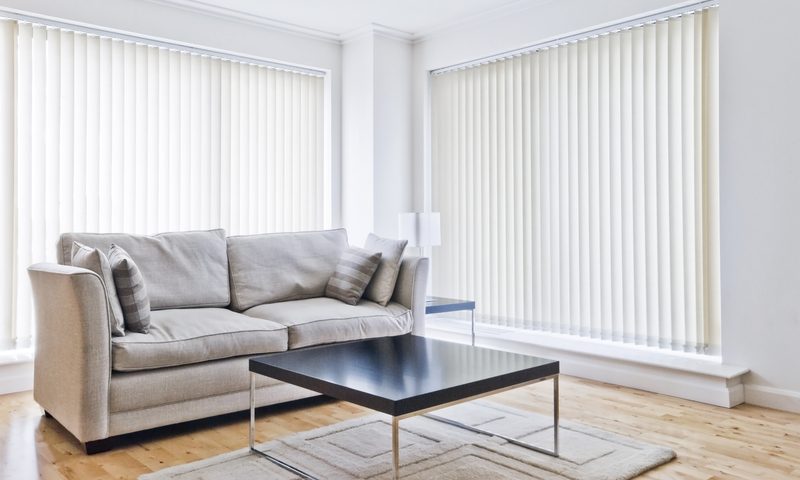PROS AND CONS OF VERTICAL OR HORIZONTAL BLINDS
This post was originally published on (27th September 2022) and updated on (28th February 2024).
Blinds are an integral part of maintaining the aesthetic of the household or office or wherever they are being put up. While the market offers innumerable options, some kinds of blinds have been around for a long time, vertical blinds and horizontal blinds. Both of them are great in serving their purpose and have their characteristics as well. However, to choose the one which suits your aesthetics and requirements, it is important to understand the intricacies of each. And that is exactly what we are about to do.
What are vertical blinds?
Vertical blinds, a commonly chosen window covering, comprise a headrail and vertical fabric strips known as louvres. The headrail extends along the window’s width, with the louvres suspended from it. Cords or a more child-safe wand option, facilitate both the drawing of the blinds across the window and the tilting of the louvres.
Features of vertical blinds
- Louvre Size Options: Choose between 89mm or 127mm louvres to customise the appearance of your vertical blinds.
- Wide Fabric Range: Access a diverse selection of fabrics from leading suppliers in the UK, offering extensive choices for personalization.
- Durable Designer Vogue Headrail: All blinds come equipped with a robust designer vogue headrail, ensuring long-lasting performance and enduring quality.
- Enhanced Light Control: Louvre slats can be tilted up to 180 degrees, providing maximum flexibility for controlling light and privacy.
- User-Friendly Operation: Opt for the standard wand control operation, ensuring easy and child-safe use without the need for cords or chains fixed to the wall. Traditional cord and chain operation is also available, adhering to child-safe regulations as standard.
- Customisable Finishes and Innovative Options: Select from multiple headrail finishes, including white, brown, silver, gold, black, or anthracite, each accompanied by coordinating weights, stabilising chains, and components. Explore options like chainless weights, eliminating the need for a stabilising chain at the bottom of the slats. For a luxurious touch, consider a motorised Vertical Headrail, offering remote-controlled tilt and draw operations.
Pros and cons of vertical blinds
Pros –
- Versatile Light Control
- Customisable Styles
- Space Efficiency and hence ideal for large windows and sliding glass.
- Their ability to tilt the louvres at different angles provides effective privacy control.
- Wand control and motorised options make them a safe choice for children
- Vertical blinds are relatively easy to clean and maintain. Regular dusting or gentle vacuuming keeps them looking fresh.
Cons –
- In windy conditions, vertical blinds may produce noise as the louvres move.
- Dust Accumulation
- Limited Insulation
Recommended Places for Vertical Blinds
- Living Room
- Bedrooms
- Office Spaces
- Patio or French Doors
- Commercial Spaces
- Apartment Balconies
What are horizontal blinds?
Horizontal blinds are more commonly known as Venetian blinds and have been a favourite of the British since the 1760s. Venetian blinds are window coverings with horizontal slats that can be adjusted for light control and privacy. Typically made of materials like wood, faux wood, or aluminium, these blinds are operated by cords or a wand. They are versatile, easy to clean, and suitable for various room designs.
Features of horizontal blinds:
Wooden Venetian Blinds
- Slat Size Options: Choose from 25mm, 35mm, or 50mm slats for a custom look and fit.
- Versatile Finishes: Extensive range of colours, grains, gloss, and perfect grain finishes, catering to diverse interior styles.
- Tilt Control for Glare Reduction: Tilt slats to control light direction, reducing glare on screens or directing light around the room.
- Matching Valance and Decorative Tapes: All blinds include a matching valance for a polished appearance and decorative tapes can be added for a luxurious finish.
- Perfect Fit Option (25mm only): Specifically designed for 25mm slats, suitable for Perfect Fit installation.
Metal Venetian Blinds
- Slat Size Variety: Available in 25mm, 35mm, or 50mm slats, providing options for different preferences.
- Colour and Texture Range: Extensive choices of colours and textures, allow for a diverse selection to complement any space.
- Privacy and Room Darkening: The privacy option enhances room darkening performance, eliminating sun spots on work areas and screens.
- Contrast Design Elements: Option for contrast headrail, bottom bar, or mixed slats in some ranges for a contemporary look.
- Perfect Fit & Intu Systems (25mm only): Specifically designed for 25mm slats, suitable for both Perfect Fit and Intu systems, ideal for door areas
Faux Wood Venetian Blinds
- Slat Options: Choose between 35mm or 50mm slats with options for fine-grain or smooth slats.
- Waterproof and Easy to Clean: Faux wood blinds are waterproof, allowing more rigorous cleaning and durability compared to most other blind types.
- Tilt Control for Glare Reduction: Tilt slats to control light direction, reducing glare on screens or achieving desired privacy.
- Decorative Tapes and Valance Options: Enhance aesthetics with matching or contrast decorative tapes and contrast metal valance and toggles for a contemporary finish.
Pros and cons of horizontal blinds
Pros –
- Horizontal blinds offer effective control over natural light.
- Versatility in Design
- Ease of Cleaning
- Customisation
- Space Efficiency
Cons –
- Limited Insulation
- Noise in Windy Conditions
- The slats of horizontal blinds can be more susceptible to damage, especially in households with pets or children
Recommended Places for Horizontal Blinds
- Living Rooms
- Offices
- Kitchens
- Bedrooms
- Dining Areas
- Study or Home Office
Choose Concorde Blinds for the ultimate aesthetic rescue!
Here at Concorde Blinds, we are as concerned for your aesthetics as you are. Trust us to provide you with nothing but the best. Contact us today or request an appointment to get the blinds of your desired aesthetics!



